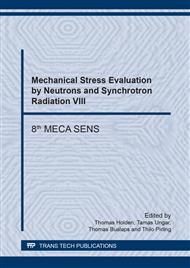[1]
C.N. Reid, Deformation geometry for material scientists, Oxford: Pergamon Press (1973).
Google Scholar
[2]
K. Wierzbanowski, A. Baczmanski, P. Lipinski and A. Lodini, Elasto-plastic models of polycrystalline material deformation and their applications, Arch. Metall. Mater., 52 (2007) 77-86.
Google Scholar
[3]
S. Wroński, K. Wierzbanowski, B. Bacroix, M. Wróbel, E. Rauch, F. Montheillet, M. Wronski, Texture heterogeneity of asymmetrically rolled low carbon steel, Arch. Metall. Mater., 54 (2009) 89-102.
DOI: 10.4028/www.scientific.net/amr.996.688
Google Scholar
[4]
Y.N. Wang, J.C. Huang, Texture analysis in hexagonal materials, Mater. Chem. Phys., 81 (2003) 11-26.
Google Scholar
[5]
M.J. Philippe, M. Serghat, P. Van Houtte, C. Esling, Modelling of texture evolution for materials of hexagonal symmetry—II. application to zirconium and titanium α or near α alloys, Acta Metall. Mater., 43 (1995) 1619-1630.
DOI: 10.1016/0956-7151(94)00329-g
Google Scholar
[6]
S. Wang, Y. Zhang, Ch. Schuman, J. -S. Lecomte, X. Zhao, L. Zuo, M. -J. Philippe, C. Esling, Study of twinning/detwinning behaviors of Ti by interrupted in situ tensile tests, Acta Mater., 82 (2015) 424–436.
DOI: 10.1016/j.actamat.2014.09.038
Google Scholar
[7]
A. Roth, M.A. Lebyodkin, T.A. Lebedkina, J. -S. Lecomte,T. Richeton, K.E.K. Amouzou, Mechanisms of anisotropy of mechanical properties of α-titanium in tension conditions, Mat. Sci. Eng. A, 596 (2014) 236–243.
DOI: 10.1016/j.msea.2013.12.061
Google Scholar
[8]
K.E.K. Amouzou , T. Richeton , A. Roth, M.A. Lebyodkin, T.A. Lebedkina, Micromechanical modeling of hardening mechanisms in commercially pure a-titanium in tensile condition, Int. J. Plasticity, 80 (2016) 222-240.
DOI: 10.1016/j.ijplas.2015.09.008
Google Scholar
[9]
B. Barkia, V. Doquet, J.P. Couzinié, I. Guillot, E. Héripré, In situ monitoring of the deformation mechanisms in titanium with different oxygen contents, Mat. Sci. Eng. A, 636 (2015) 91–102.
DOI: 10.1016/j.msea.2015.03.044
Google Scholar
[10]
B. Barkia, V. Doquet, E. Héripré, I. Guillot, Characterization and analysis of deformation heterogeneities in commercial purity titanium, Mater. Charact., 108 (2015) 94–101.
DOI: 10.1016/j.matchar.2015.09.001
Google Scholar
[11]
H.J. Bunge, Texture Analysis in Material Science, pp.3-41, Butterworths, London (1982).
Google Scholar
[12]
J. Tarasiuk, K. Wierzbanowski, A. Baczmanski, New Algorithm of Direct Method of Texture Analysis, Cryst. Res. Technol., 33 (1998) 101- 118.
DOI: 10.1002/(sici)1521-4079(1998)33:1<101::aid-crat101>3.0.co;2-7
Google Scholar
[13]
N. Benmhenni, S. Bouvier, R. Brenner, T. Chauveau, B. Bacroix, Micromechanical modelling of monotonic loading of CP α-Ti: Correlation between macroscopic and microscopic behaviour, Mat. Sci. Eng. A-struct, 573 (2013) 222–233.
DOI: 10.1016/j.msea.2013.02.022
Google Scholar
[14]
S. Yu. Mironov, G. A. Salishchev, M. M. Myshlyaev, R. Pippan, Evolution of misorientation distribution during warm abc, forging of commercial-purity titanium, Mat. Sci. Eng. A-struct., 418 (2006) 257–267.
DOI: 10.1016/j.msea.2005.11.026
Google Scholar
[15]
S. Wronski, K. Wierzbanowski, M. Jędrychowski, J. Tarasiuk, M. Wronski, A. Baczmanski, B. Bacroix, Microstructure evolution of titanium after tensile test, Mat. Sci. Eng. A, 656 (2016) 1–11.
DOI: 10.1016/j.msea.2015.12.041
Google Scholar
[16]
A. Baczmanski, K. Wierzbanowski, J. Tarasiuk, M. Ceretti, A. Lodini, Anisotropy of Micro-Stresses Measured by Diffraction, Rev. Metall. - Paris, 94 (1997) 1467- 1474.
DOI: 10.1051/metal/199794121467
Google Scholar
[17]
A. Baczmanski, A. Tidu, P. Lipinski, M. Humbert, and K. Wierzbanowski, New Type of Diffraction Elastic Constants for Stress Determination, Mater. Sci. Forum, 524-525 (2006) 235-240.
DOI: 10.4028/www.scientific.net/msf.524-525.235
Google Scholar
[18]
S. Wronski, M. Wrobel, A. Baczmanski, K. Wierzbanowski, Effects of cross-rolling on residual stress, texture and plastic anisotropy in f. c. c. and b. c. c. metals, Mater. Charact., 77 (2013) 116 – 126.
DOI: 10.1016/j.matchar.2013.01.005
Google Scholar
[19]
G.K. Williamson, W.H. Hall, X-ray line broadening from filed Al and W, Acta Metall., 1 (1953) 22-31.
Google Scholar
[20]
J.D. Martin, Using XPowder: A software package for Powder X-Ray diffraction analysis, www. xpowder. com 2004; D.L. GR 1001/04. ISBN 84-609-1497-6.
Google Scholar


